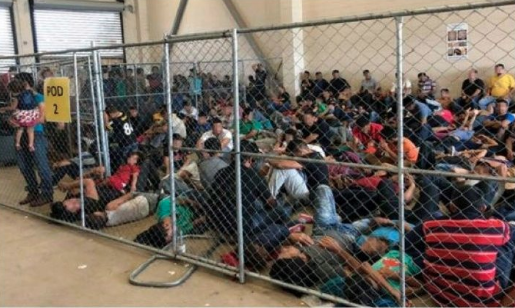At least three children have died this year as a result of the flu while in Customs and Border Protection custody, a rate almost 10 times higher than the United States average. With flu season approaching, CBP has said they are doing all they can with an overloaded system that was never meant to care for vulnerable people.
Last week a group of six doctors associated with Harvard and Johns Hopkins University wrote a letter to two House representatives to bring attention to the threat of infectious diseases within migrant detention facilities that are housing children, warning the problem will get worse without appropriate action.
Since December 2018, six children have died while in federal custody, among them were a two, six, and 16-year-old who all died from the flu. Prior to September 2018, it had been a decade since a child had died in CBP custody.
“Poor conditions at the facilities may be amplifying the spread of influenza and other infectious diseases, increasing health risks to children,” stated the letter addressed to Rep. Rosa DeLauro, who chairs the committee that oversees the Department of Health and Human Services, and Rep. Lucille Roybal-Allard, who chairs the subcommittee on Homeland Security.
The Flu in Detention Facilities
In the United States, dying from the flu is relatively rare. Each season around 1 in 600,000 children die as a result of the flu, whereas in detention facilities the rate is much higher, with around 3 in 200,000 dying, according to the letter. There are many factors that contribute to this disparity between the two populations, the letter said, one being that migrants are generally more vulnerable to the flu due to lower rates of immunization and inadequate healthcare during early childhood.
CBP detention facilities are also at greater risk of a spreadable disease outbreak because they have a mix of long-term detainees along with a continual flow of short-term detainees. The rapid turnover of migrants is known as the “revolving door” effect and can amplify the risk of transmission between the two groups, the letter stated.
“This revolving door effect is a growing concern as border facilities designed for short term detention are increasingly being used to detain migrants for longer periods of time,” the doctors said.
The group of doctors compiled a list of eight measures health personnel can take to minimize the risk of a flu outbreak in detention facilities. These include screening incoming children for illnesses, isolating them if they show signs of the flu, and taking preventative measures such as vaccinating all children above the age of six months.
“Given the known risks of influenza in detention, facilities overseen by the Department of Homeland Security and the Department of Health and Human Services should meet basic standards for screening, isolation, treatment, and prevention,” the letter said. “Many of these standards are important to limit the spread of other infectious diseases.”
What Is Customs and Border Protection Doing?
CBP detention facilities were not built to house long-term detainees. Rather they were meant to be a processing center where migrants would be held for a maximum of 72 hours and then handed over to Immigration and Customs Enforcement, better known as ICE. But two of the children who died while in CBP custody had been held for six days. With many detainees staying longer than the 72-hour window, CBP is overwhelmed and lacking the medical resources migrants need.
“As DHS [Department of Homeland Security] and CBP leadership have noted numerous times in testimony to Congress and in numerous media engagements that our short-term holding facilities were not designed to hold vulnerable populations,” a CBP spokesperson said via email to The Globe Post.
However, the conditions within the facilities are more than just overpopulated. One doctor who visited a CBP detention facility in Texas told ABC News that the children detainees suffered “extreme cold temperatures, lights on 24 hours a day, no adequate access to medical care, basic sanitation, water, or adequate food.”
These poor conditions may contribute to the spread of diseases such as the flu, stated the letter, especially among vulnerable groups such as children.
The CBP spokesperson highlighted that the agency recently received a bump in funding to help deal with the increase of migrants. An extra $63 million allocated to be spent on additional medical assets such as ambulances, and pediatric specialists. Additionally, $48 million was allocated to be spent on food and hygiene, including shower stalls and portable toilets for detainees.
CBP also has increased the number of medical personnel within their facilities along the southern U.S border from just 20 a year ago, to over 200 today. Also, in high volume areas such as the Rio Grande Valley and El Paso medical personnel are available 24/7, said the spokesperson. But, recently there have been reports that medical care is being withheld from detainees when requested.
A key factor in stopping an outbreak of a spreadable disease is by isolating detainees who are showing early symptoms, the letter said. Currently, in CBP facilities they try to isolate or cohort people who are showing signs of the flu, but with limited space and operational constraints they are not always able to do this, said the spokesperson.
“Individuals with flu are handled as appropriate depending on the specific circumstances. Those migrants with the flu may be diagnosed and treated on-site by CBP medical personnel, or may be referred as appropriate to the local health system for diagnosis and treatment,” they said.
Coming into flu season the doctors fear that if precautions are not being taken now flu deaths will continue to increase.
“With so many lives at risk, these issues are worthy of Congressional investigation,” the letter stated. “Another influenza season is around the corner, and there are other types of infectious diseases that pose a threat to detained populations. Timely action is critical.”
More on the Subject
UN Rights Chief ‘Shocked’ by Conditions at US Migrant Detention Centers























